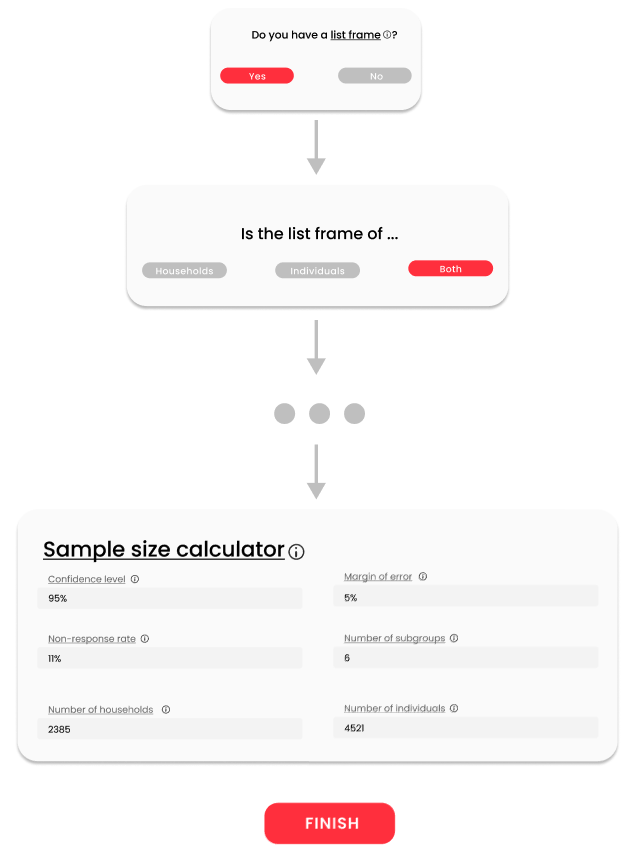UI DESIGN
- Home
- UI Design
Design Principles
Always Place the User at the Center
When introducing a sampling tool, it's crucial to adopt the design principle that places
the user at the forefront of the design process. The success of any sampling tool depends on
its ability to provide a user-friendly interface that meets the needs and expectations of its users.
A well-designed user interface should be intuitive, easy to navigate, and avoid confusing the user.
To achieve this, it's essential to understand your target audience and their requirements. By conducting
interviews with potential users, you can gain valuable insights into their preferences and behaviors.
Incorporating human-centered design principles can help you create a sampling tool that prioritizes the
user's needs and desires, ensuring a positive user experience. Remember, focusing on people first and design
second is key to developing a successful and effective sampling tool.
Strive for Clarity
The user interface serves as the medium for users to interact with a website,
application, or any other product. The primary objective is
to create a user-friendly interface that facilitates interaction
and avoids any elements that may cause confusion or
impede usability. In broader design, the focus remains
on ensuring that the product is designed in a manner that
enables smooth and seamless interaction, keeping the user's
experience in mind. The interface should serve as a means of
enhancing user engagement and not cause any unnecessary hindrances
that may deter user satisfaction.
Simplicity
Classics endure because they possess a timeless quality that never fades,
even though they may benefit from contemporary updates. For example,
the little black cocktail dress or the tuxedo are fashion staples that exude sophistication and add a touch
of refinement to the wearer. Similarly, a good user interface should possess simplicity and elegance,
evoking a sense of sophistication and refinement in the user experience. The interface should be uncluttered,
easy to navigate, and visually appealing, enabling users to engage seamlessly with the product or service.
Ultimately, simplicity and elegance are key to creating a memorable and enduring user interface that stands the test of time.
Besides the above design principles, we design our UI according to the IFRC User Library:
Sketches
After gathering the user requirements and using personas to better understand them, we drew up the sketches to explore ideas on the UI of our sampling tool. The sketching was done based on our design principles summarized above.
Sketch 1
This was the first sketch designed by the team for IFRC in consideration with all the pain points and user interface guidelines provided by the client. An entire page dedicated to the meaning of different terms used in sampling to guide the users. The explanation of the result and simpler UI are also addressed.

Sketch 2
This was another alternative that was designed after reviews of the first sketch from the users. They preferred the meanings of the terms to be displayed on the same page rather than another redirected page. So each time the user clicks on a term, the help window on the right side of the screen displays the meaning of the term and the term is underlined.

Wireframes
PROTOTYPE - IFRC

PROTOTYPE - EXPLAINED WITH AN EXAMPLE

Our Improved Prototype:

Evaluation of Prototype:
| Heuristic | Problem | Solution | Severity (Scale 1-5) |
|---|---|---|---|
Consistency and standards | Language barrier as the tool is only available in English. | The tool could be operated using various major languages. | 3 |
Aesthetic and minimalist design | Hard to navigate the sampling tool. Steps to follow were not clear for the users. Crowded layout. | Use of cards to clearly distinguish different sections. Tree-like decision path to guide users through the sampling design. | 5 |
Flexibility and efficiency of use | The users would like to see the data that they input after getting redirected to the next page. | The input is still displayed on the screen in a dim way for the users. | 2 |
Figma UI Design
Having gone through multiple iterations of the design by sketching, prototyping and wireframing we finally arrived to our final UI design. The design was made using Figma and this was our main reference point while developing the UI and its components.

References:
- 1. British Red Cross. (2022). The Global Surge Team. https://www.redcross.org.uk/about-us/what-we-do/international/global-surge-team
- 2. M.Amin.(No date). Disaster Response. https://prcs.org.pk/disaster-response/
- 3. Preece, J., Sharp, H., & Rogers, Y. (2015). Interaction design: beyond human-computer interaction. 4th ed. West Sussex: Wiley.
